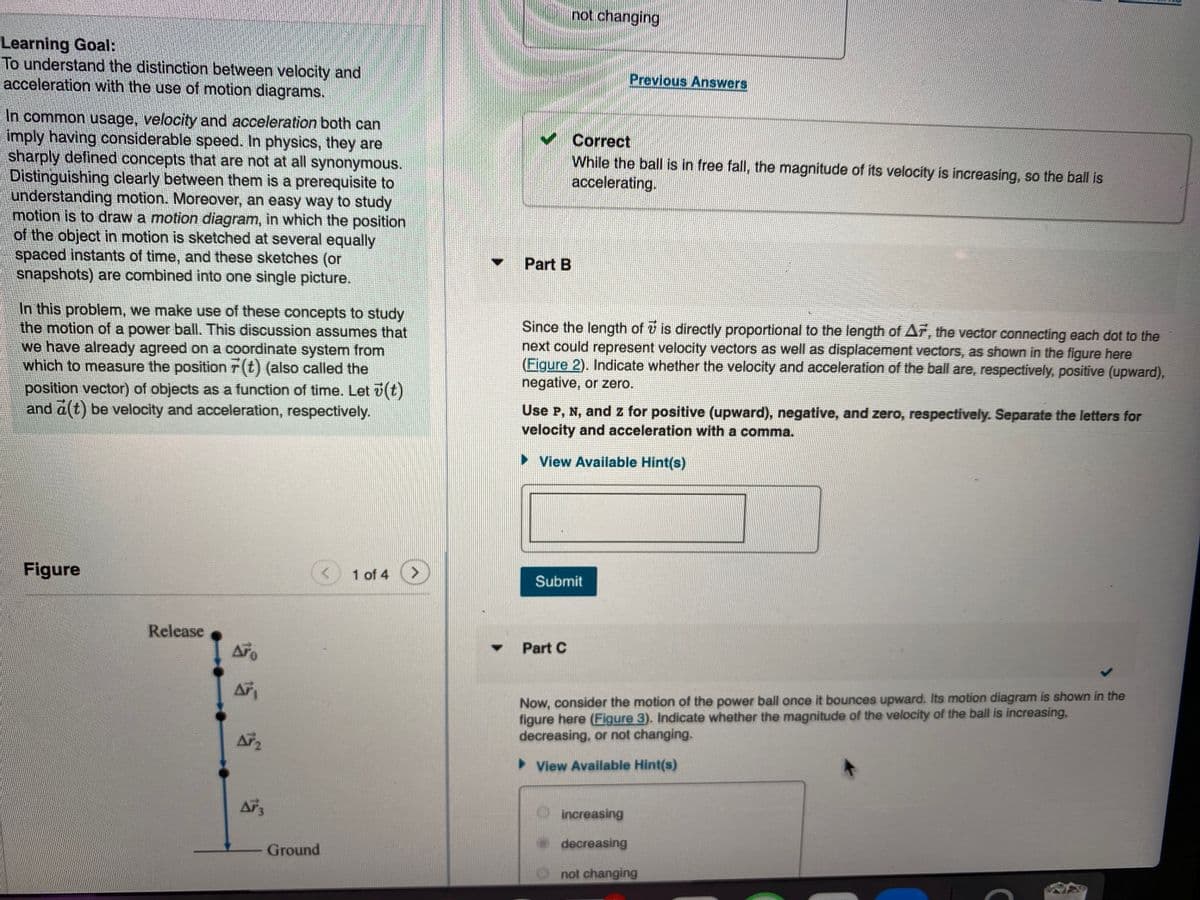Part B Since the length of v is directly proportional to the length of AF, the vector connecting each dot to the next could represent velocity vectors as well as displacement vectors, as shown in the figure here (Figure 2). Indicate whether the velocity and acceleration of the ball are, respectively, positive (upward negative, or zero. Use P, N, and z for positive (upward), negative, and zero, respectively. Separate the letters for velocity and acceleration with a comma. > View Available Hint(s) Submit Part C Now, consider the motion of the power ball once it bounces upward. Its motion diagram is shown in the figure here (Figure 3). Indicate whether the magnitude of the velocity of the ball is increasing, decreasing, or not changing. > View Available Hint(s) O increasing decreasing O not changing
Part B Since the length of v is directly proportional to the length of AF, the vector connecting each dot to the next could represent velocity vectors as well as displacement vectors, as shown in the figure here (Figure 2). Indicate whether the velocity and acceleration of the ball are, respectively, positive (upward negative, or zero. Use P, N, and z for positive (upward), negative, and zero, respectively. Separate the letters for velocity and acceleration with a comma. > View Available Hint(s) Submit Part C Now, consider the motion of the power ball once it bounces upward. Its motion diagram is shown in the figure here (Figure 3). Indicate whether the magnitude of the velocity of the ball is increasing, decreasing, or not changing. > View Available Hint(s) O increasing decreasing O not changing
University Physics Volume 1
18th Edition
ISBN:9781938168277
Author:William Moebs, Samuel J. Ling, Jeff Sanny
Publisher:William Moebs, Samuel J. Ling, Jeff Sanny
Chapter3: Motion Along A Straight Line
Section: Chapter Questions
Problem 70P: Unreasonable results A dolphin in an aquatic show jumps straight up out of the water at a velocity...
Related questions
Question

Transcribed Image Text:not changing
Learning Goal:
To understand the distinction between velocity and
acceleration with the use of motion diagrams.
Previous Answers
In common usage, velocity and acceleration both can
imply having considerable speed. In physics, they are
sharply defined concepts that are not at all synonymous.
Distinguishing clearly between them is a prerequisite to
understanding motion. Moreover, an easy way to study
motion is to draw a motion diagram, in which the position
of the object in motion is sketched at several equally
spaced instants of time, and these sketches (or
napshots) are combined into one single picture.
Correct
While the ball is in free fall, the magnitude of its velocity is increasing, so the ball is
accelerating.
Part B
In this problem, we make use of these concepts to study
the motion of a power ball. This discussion assumes that
we have already agreed on a coordinate system from
which to measure the position r (t) (also called the
Since the length of v is directly proportional to the length of Ar, the vector connecting each dot to the
next could represent velocity vectors as well as displacement vectors, as shown in the figure here
(Figure 2). Indicate whether the velocity and acceleration of the ball are, respectively, positive (upward),
negative, or zero.
position vector) of objects as a function of time. Let v(t)
and a(t) be velocity and acceleration, respectively.
Use P, N, and z for positive (upward), negative, and zero, respectively. Separate the letters for
velocity and acceleration with a comma.
> View Available Hint(s)
Figure
1 of 4
Submit
Release
Part C
Now, consider the motion of the power ball once it bounces upward. Its motion diagram is shown in the
figure here (Figure 3). Indicate whether the magnitude of the velocity of the ball is increasing,
decreasing, or not changing.
> View Available Hint(s)
increasing
decreasing
Ground
O not changing
Expert Solution
This question has been solved!
Explore an expertly crafted, step-by-step solution for a thorough understanding of key concepts.
This is a popular solution!
Trending now
This is a popular solution!
Step by step
Solved in 2 steps

Knowledge Booster
Learn more about
Need a deep-dive on the concept behind this application? Look no further. Learn more about this topic, physics and related others by exploring similar questions and additional content below.Recommended textbooks for you

University Physics Volume 1
Physics
ISBN:
9781938168277
Author:
William Moebs, Samuel J. Ling, Jeff Sanny
Publisher:
OpenStax - Rice University

Glencoe Physics: Principles and Problems, Student…
Physics
ISBN:
9780078807213
Author:
Paul W. Zitzewitz
Publisher:
Glencoe/McGraw-Hill

College Physics
Physics
ISBN:
9781938168000
Author:
Paul Peter Urone, Roger Hinrichs
Publisher:
OpenStax College

University Physics Volume 1
Physics
ISBN:
9781938168277
Author:
William Moebs, Samuel J. Ling, Jeff Sanny
Publisher:
OpenStax - Rice University

Glencoe Physics: Principles and Problems, Student…
Physics
ISBN:
9780078807213
Author:
Paul W. Zitzewitz
Publisher:
Glencoe/McGraw-Hill

College Physics
Physics
ISBN:
9781938168000
Author:
Paul Peter Urone, Roger Hinrichs
Publisher:
OpenStax College

College Physics
Physics
ISBN:
9781285737027
Author:
Raymond A. Serway, Chris Vuille
Publisher:
Cengage Learning

An Introduction to Physical Science
Physics
ISBN:
9781305079137
Author:
James Shipman, Jerry D. Wilson, Charles A. Higgins, Omar Torres
Publisher:
Cengage Learning